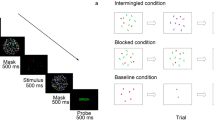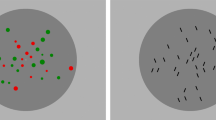Summary
It is widely believed that humans are endowed with a specialized numerical process, calledsubitizing, which enables them to apprehend rapidly and accurately the numerosity of small sets of objects. A major part of the evidence for this process is a purported discontinuity in the mean response time (RT) versus numerosity curves at about 4 elements, when subjects enumerate up to 7 or more elements in a visual display. In this article, RT data collected in a speeded enumeration experiment are subjected to a variety of statistical analyses, including several tests on the RT distributions. None of these tests reveals a significant discontinuity as numerosity increases. The data do suggest a strong stochastic dominance in RT by display numerosity, indicating that the mental effort required to enumerate does increase with each additional element in the display, both within and beyond the putative subitizing range.
Similar content being viewed by others
References
Ashby, F. G. (1982). Testing the assumptions of exponential, additive reaction time models.Memory & Cognition, 10, 125–134.
Ashby, F. G., & Townsend, J. T. (1980). Decomposing the reaction time distribution: Pure insertion and selective influence revisited.Journal of Mathematical Psychology, 21, 93–123.
Ashby, F. G., Tein, J., & Balakrishnan, J. D. (1991). Response time distributions in memory scanning. Submitted.
Balakrishnan, J. D., & Ashby, F. G. (1991). Is subitizing a unique numerical ability?Perception & Psychophysics, 50, 555–564.
Broadbent, D. E. (1975). The magic number seven after fifteen years. In A. Wilkes & A. Kennedy (Eds.),Studies in long term memory. New York: Wiley.
Burbeck, S. L., & Luce, R. D. (1982). Evidence from auditory simple reaction times for both change and level detectors.Perception & Psychophysics, 32, 117–133.
Cattell, J. M. (1886). Ueber die Trägheit der Netzhaut and des Sehzentrums.Philosophische Studien, 3, 94–127.
Chi, M. T. H., & Klahr, D. (1975). Span and rate of apprehension in children and adults.Journal of Experimental Child Psychology, 19, 434–439.
Colonius, H. (1990). Possibly dependent probability summation of reaction time.Journal of Mathematical Psychology, 34, 253–275.
Hockley, W. E. (1984). Analysis of response time distributions in the study of cognitive processes.Journal of Experimental Psychology: Learning, Memory, and Cognition, 10, 598–615.
Kaufman, E. L., Lord, M. W., Reese, T. W., & Volkmann, J. (1949). The discrimination of visual number.American Journal of Psychology, 62, 498–525.
Klahr, D., & Wallace, J. G. (1976).Cognitive development: An information processing view. Hillsdale, NJ: Erlbaum.
Krueger, L. E. (1984). Perceived numerosity: A comparison of magnitude production, magnitude estimation, and discrimination judgements.Perception & Psychophysics, 35, 536–542.
Laming, D. (1973).Mathematical psychology. New York: Academic Press.
Luce, R. D. (1986).Response times: Their role in inferring elementary mental organization. New York: Oxford University Press.
Mandler, G., & Shebo, B. J. (1982). Subitizing: An analysis of its component processes.Journal of Experimental Psychology: General, 111, 1–22.
Miller, D. R., & Singpurwalla, N. D. (1977).Failure rate estimation using random smoothing. National Technical Information Service, No. AD-A040999/5ST.
Miller, G. A. (1956). The magical number seven plus or minus two: Some limits on our capacity to process information.Psychological Review, 63, 81–97.
Neisser, U. (1967).Cognitive psychology. Englewood Cliffs, NJ: Prentice-Hall.
van Oeffelen, M. P., & Vos, P. G. (1982a). Configurational effects on the enumeration of dots: Counting by groups.Memory & Cognition, 10, 396–404.
van Oeffelen, M. P., & Vos, P. G. (1982b). A probabilistic model for the discrimination of visual number.Perception & Psychophysics, 32, 163–170.
Oyama, T., Kikuchi, T., & Ichihara, S. (1981). Span of attention, backward masking, and reaction time.Perception & Psychophysics, 29, 106–112.
Parzen, E. (1960).Modern probability theory and its applications. New York: Wiley.
Peterson, W. W., Birdsall, T. G., & Fox, W. C. (1954). The theory of signal detectability.Trans. IRE Professional Group on Information Theory, PGIT-4, 171–212.
Ratcliff, R. (1978). A theory of memory retrieval.Psychological Review, 85, 59–108.
Ratcliff, R. (1988). A note on mimicking additive reaction time models.Journal of Mathematical Psychology, 32, 192–204.
Silverman, B. W. (1986).Density estimation for statistics and data analysis. London: Chapman & Hall.
Simons, D., & Langheinrich, D. (1982). What is magic about the magical number four?Psychological Research, 44, 283–294.
Starkey, P., & Cooper, R. G. (1980). Perception of number by human infants.Science, 210, 1033–1035.
Starkey, P., Spelke, E. S., & Gelman, R. (1983). Detection of intermodal numerical correspondences by human infants.Science, 222 179–181.
Sternberg, S. (1969). The discovery of processing stages: Extensions of Donders' method. In W. G. Koster (Ed.),Attention and performance (Vol. 2). Amsterdam: North Holland.
Townsend, J. T. (1988). The truth and consequences of ordinal differences in statistical distributions: Toward a theory of hierarchical inference.Psychological Bulletin, 108, 551–567.
Townsend, J. T., & Ashby, F. G. (1983). Stochastic modeling of elementary psychological processes. Cambridge: Cambridge University Press.
Von Szeliski, V. (1924). Relation between the quantity perceived and the time of perception.Journal of Experimental Psychology, 7, 135–147.
Woodworth, R. S., & Schlosberg, H. (1954).Experimental psychology. New York: Holt.
Wundt, W. (1896). Grundriß der Psychologie. Leipzig: Engelmann.
Author information
Authors and Affiliations
Rights and permissions
About this article
Cite this article
Balakrishnanl, J.D., Ashby, F.G. Subitizing: Magical numbers or mere superstition?. Psychol. Res 54, 80–90 (1992). https://doi.org/10.1007/BF00937136
Received:
Accepted:
Issue Date:
DOI: https://doi.org/10.1007/BF00937136




